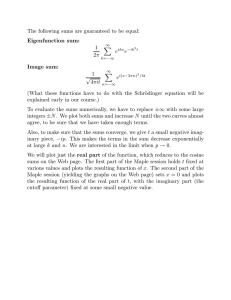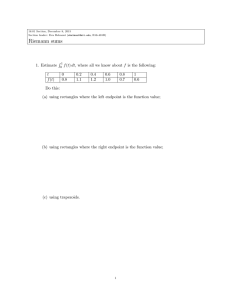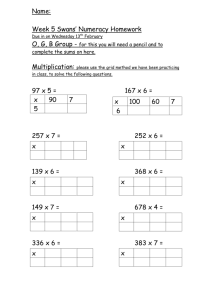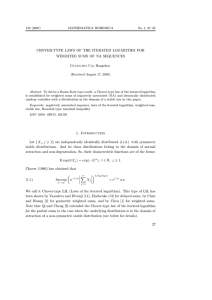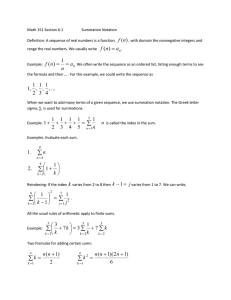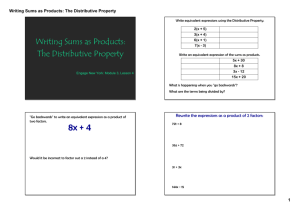CHOVER-TYPE LAWS OF THE ITERATED LOGARITHM FOR WEIGHTED SUMS OF -MIXING SEQUENCES ρ
advertisement
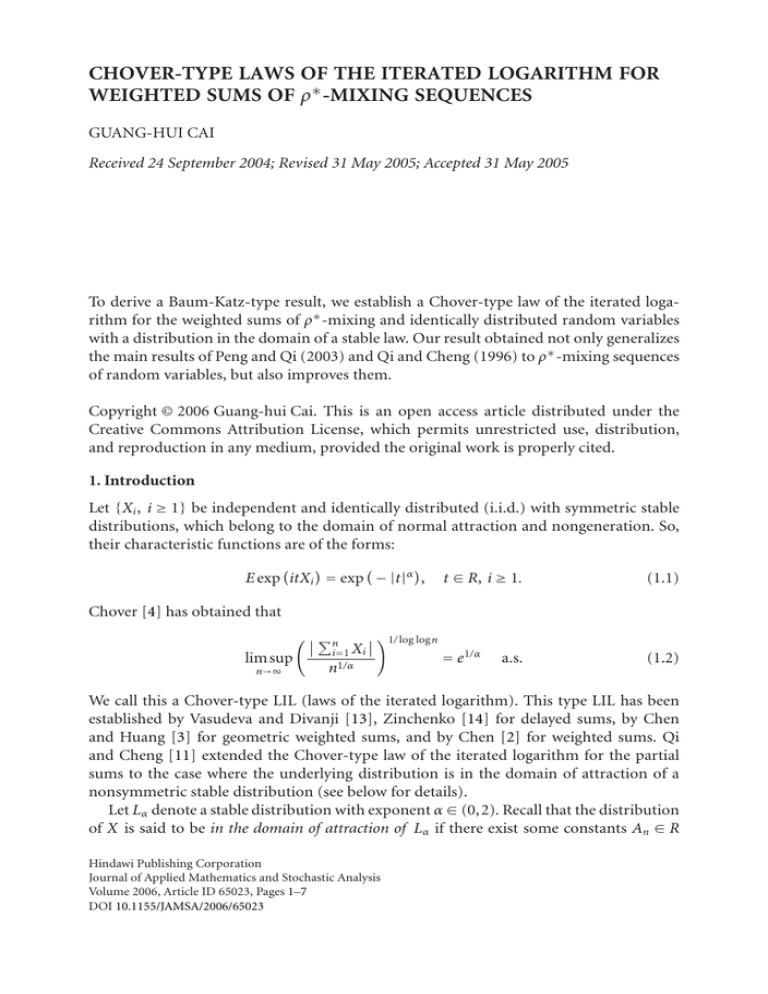
CHOVER-TYPE LAWS OF THE ITERATED LOGARITHM FOR
WEIGHTED SUMS OF ρ∗ -MIXING SEQUENCES
GUANG-HUI CAI
Received 24 September 2004; Revised 31 May 2005; Accepted 31 May 2005
To derive a Baum-Katz-type result, we establish a Chover-type law of the iterated logarithm for the weighted sums of ρ∗ -mixing and identically distributed random variables
with a distribution in the domain of a stable law. Our result obtained not only generalizes
the main results of Peng and Qi (2003) and Qi and Cheng (1996) to ρ∗ -mixing sequences
of random variables, but also improves them.
Copyright © 2006 Guang-hui Cai. This is an open access article distributed under the
Creative Commons Attribution License, which permits unrestricted use, distribution,
and reproduction in any medium, provided the original work is properly cited.
1. Introduction
Let {Xi , i ≥ 1} be independent and identically distributed (i.i.d.) with symmetric stable
distributions, which belong to the domain of normal attraction and nongeneration. So,
their characteristic functions are of the forms:
E exp itXi = exp − |t |α ,
t ∈ R, i ≥ 1.
(1.1)
= e1/α
(1.2)
Chover [4] has obtained that
limsup
n→∞
n
1/ log logn
i=1 Xi
n1/α
a.s.
We call this a Chover-type LIL (laws of the iterated logarithm). This type LIL has been
established by Vasudeva and Divanji [13], Zinchenko [14] for delayed sums, by Chen
and Huang [3] for geometric weighted sums, and by Chen [2] for weighted sums. Qi
and Cheng [11] extended the Chover-type law of the iterated logarithm for the partial
sums to the case where the underlying distribution is in the domain of attraction of a
nonsymmetric stable distribution (see below for details).
Let Lα denote a stable distribution with exponent α ∈ (0,2). Recall that the distribution
of X is said to be in the domain of attraction of Lα if there exist some constants An ∈ R
Hindawi Publishing Corporation
Journal of Applied Mathematics and Stochastic Analysis
Volume 2006, Article ID 65023, Pages 1–7
DOI 10.1155/JAMSA/2006/65023
2
Chover-type LIL for weighted sums of mixing sequences
and Bn > 0 such that
Sn −An
Bn
d
Lα .
(1.3)
Under (1.3), Qi and Cheng [11] and Peng and Qi [10] showed that
limsup
n
1/ log logn
i=1 Xi − An
Bn
n→∞
= e1/α
a.s.
(1.4)
It is well known that (1.3) holds if and only if
1 − F(x) =
C1 (x)l(x)
,
xα
F(−x) =
C2 (x)l(x)
,
xα
for x > 0,
(1.5)
where, for x > 0, Ci (x) ≥ 0, limx→∞ Ci (x) = Ci , i = 1,2, C1 + C2 > 0, and l(x) ≥ 0 is slowly
varying in the sense of Karamata function, that is,
lim
t →∞
l(tx)
= 1,
l(t)
for x > 0.
(1.6)
By Lin et al. [6, page 76, Exercise 21], we have Bn = (nl(n))1/α .
For nonempty sets S,T ⊂ ᏺ, we define ᏲS = σ(Xk , k ∈ S). And we define the maximal
correlation coefficient ρn∗ = supcorr( f ,g) where the supremum is taken over all (S,T)
with dist(S,T) ≥ n and for all f ∈ L2 (ᏲS ), g ∈ L2 (ᏲT ), and dist(S,T) = inf x∈S, y∈T |x − y |.
A sequence of random variables {Xn , n ≥ 1} on a probability space {Ω,Ᏺ,P } is called
ρ∗ -mixing if
∗
lim ρ
n→∞ n
= 0.
(1.7)
As for ρ∗ -mixing sequences of random variables, one can refer to Bryc and Smolenski
[1], who established bounds for the moments of partial sums for a sequence of random
variables satisfying
∗
lim ρ
n→∞ n
< 1.
(1.8)
Peligrad [7] established a CLT. Peligrad [8] established an invariance principle. Peligrad
and Gut [9] established Rosenthal-type maximal inequalities and Baum-Katz-type results. Utev and Peligrad [12] established an invariance principle of nonstationary sequences.
To derive a Baum-Katz-type result, the main purpose of this paper is to establish a
Chover-type law of the iterated logarithm for the weighted sums of ρ∗ -mixing and identically distributed random variables with a distribution in the domain of a stable law. Our
result not only generalizes the main results of Peng and Qi [10] and Qi and Cheng [11]
to ρ∗ -mixing sequences of random variables, but also improves them.
Throughout this paper, let h ∈ B[0,1] denote that the function h is bounded on [0,1].
C will represent a positive constant though its value may change from one appearance to
the next, and an = O(bn ) will mean an ≤ Cbn .
Guang-hui Cai 3
2. The main results
In order to prove our results, we need the following lemma and definition.
Lemma 2.1 (Utev and Peligrad [12]). Let {Xi , i ≥ 1} be a ρ∗ -mixing sequence of random
variables, EXi = 0, E|Xi | p < ∞ for some p ≥ 2 and for every i ≥ 1. Then there exists C = C(p),
such that
⎧
k p
n
p/2 ⎫
n
⎨
⎬
p
2
Xi +
≤C
X
E
EX
.
E max i
i
⎩
⎭
1≤k≤n i =1
i=1
(2.1)
i =1
Definition 2.2 (Lin and Lu [5]). A function f (x) > 0 (x > 0) is said to be quasimonotone
nondecreasing, if
limsup sup
x→∞
0≤t ≤x
f (t)
< ∞.
f (x)
(2.2)
Here are our main results.
Theorem 2.3. Let {X,Xi , i ≥ 1} be a ρ∗ -mixing sequence of identically distributed random
variables. Let h be a bounded function on [0,1], continuous at x0 ∈ (0,1). Let Sn =
n
h(i/n)X
i , EX = 0, when α > 1. Let f (x) > 0 be quasimonotone nondecreasing and
=
1
i
∞
1 (1/x f (x))dx < ∞. Then under condition (1.3), for any ε > 0,
∞
n−1 P max S j > ε n f (n)l(n)
1≤ j ≤n
n =1
1/α
< ∞.
Proof of Theorem 2.3. For any i ≥ 1, define Xi(n) = Xi I(|Xi | ≤ an ), S(n)
j =
(n)
1/α
Eh(i/n)Xi ), where an = (n f (n)l(n)) . Then for any ε > 0,
P max S j > εan
(2.3)
j
(n)
i=1 (h(i/n)Xi −
1≤ j ≤n
j
i (n) (n) ≤ P max X j > an + P max S j
> εan − max Eh
Xi .
1≤ j ≤n
1≤ j ≤n
1≤ j ≤n
n
(2.4)
i =1
First we show that
1
i
(n) −→ 0,
max Eh
X
i
an 1≤ j ≤n i=1
n
j
as n −→ ∞.
(2.5)
4
Chover-type LIL for weighted sums of mixing sequences
In fact, (i) when 0 < α ≤ 1, h ∈ B[0,1]. For any positive integers n,N,
i
1
(n) max Eh
X
an 1≤ j ≤n i=1
n i j
Cn
1 i
≤
Eh
X (n) ≤
a n i =1
n i
an
n
Cn
Cn
≤
aN +
an
an
|x|≤an
|x|dF(x)
(2.6)
aN <|x|≤an
|x|dF(x) =: C(A + B).
Since f (x) > 0 is a quasimonotone nondecreasing and by (1.5), we have, for n ≥ N, N
large enough,
n B=
an k=N+1
n
n
≤C
n ak P ak−1 < |X | ≤ ak
an k=N+1
n
ak−1 <|x|≤ak
|x|dF(x) ≤
kP ak−1 < |X | ≤ ak ≤ CNP |X | ≥ aN + C
k=N+1
(2.7)
k =N
∞
≤C
∞
P |X | ≥ ak
1
1
1
≤C
+C
+C
f (N)
k f (k)
f (N)
k =N
∞
N
dx
ε
< .
k f (k) 4
It is obvious that for each given N,
A ≤ C
aN
1/α −→ 0,
f (n)
as n −→ ∞.
(2.8)
So, for 0 < α ≤ 1, we have (2.5).
(ii) When 1 < α < 2, using EXi = 0, h ∈ B[0,1], and (1.5), when n → ∞, we have
i
1
(n) max Eh
X
i
an 1≤ j ≤n i=1
n
j
1
i
1 i
max Eh
Xi I Xi > an E h
Xi I Xi > an
≤
=
an 1≤ j ≤n i=1
n
a n i =1
n
j
≤
Cn
Cn
E|X |I |X | > an =
an
an
=
n 1−α
C
ε
Can =
< .
an
f (n) 2
∞
an
n
P |X | ≥ x dx =
Cn
an
∞
an
(2.9)
Cl(n)
dx
xα
So, for 1 < α < 2, we also have (2.5). Hence (2.5) holds for 0 < α < 2.
By (2.4) and (2.5), we have that
P max S j > εan ≤
1≤ j ≤n
n
ε
> an ,
P X j > an + P max S(n)
j
j =1
1≤ j ≤n
2
(2.10)
Guang-hui Cai 5
for n large enough. Hence we need only to prove
∞
I =:
n −1
n =1
II =:
∞
n =1
n
P X j > an < ∞,
j =1
(2.11)
ε
> an < ∞.
n−1 P max S(n)
j
2
1≤ j ≤n
From (1.5), it is easily seen that
I=
∞
∞
P |X | > an ≤
C
≤C
n
f
(n)
n =1
n =1
∞
1
dx
< ∞.
x f (x)
(2.12)
By Lemma 2.1 and the fact that h ∈ B[0,1], it follows that
II ≤ C
∞
n =1
≤C
=C
a2n
1≤ j ≤n
≤C
∞
n −1
n =1
∞
∞
1
1
E|X |2 I |X | ≤ an = C
2
a
a2
n =1 n
n =1 n
∞
n 1 a2n k=1
n =1
≤C
2 1
n−1 E max S(n)
j
∞
2
ak−1 <|x|≤ak
x dF(x) ≤ C
n
2
1 i
E
h
Xi(n) 2
an i=1
n
∞
x2 dF(x)
|x|≤an
a2k P
ak−1 < |X | ≤ ak
∞
1
k =1
kP ak−1 < |X | ≤ ak ≤ C
k =1
∞
1
n =k
(2.13)
a2n
dx
< ∞,
x f (x)
which completes the proof of Theorem 2.3.
Corollary 2.4. Under the conditions of Theorem 2.3,
limsup
n→∞
Sn 1/ loglogn
Bn
≤ e1/α
a.s.
(2.14)
Proof of Corollary 2.4. Notice that for any positive integer n, there exists an nonnegative
integer k, such that 2k ≤ n < 2k+1 . And there exists a t ∈ [0,1), such that n = 2k+t . By (2.3),
we have
∞ 2
−1
k+1
2k+1 − 1
−1
k=0 n=2k
P
1/α
max S j > ε 2k+1 f 2k+t l 2k+t
< ∞.
1≤ j ≤2k+t
(2.15)
Then
∞
P
k =0
1/α
max S j > ε 2k+1 f 2k+t l 2k+t
< ∞.
1≤ j ≤2k+t
(2.16)
6
Chover-type LIL for weighted sums of mixing sequences
Then
max1≤ j ≤2k+t S j 2k+1 f 2k+t l 2k+t
1/α −→ 0
a.s.
(2.17)
So
Sn n f (n)l(n)
1/α ≤ max1≤ j ≤2k+t S j 2k+1 f 2k+t l 2k+t
1/α
n f (n)
≤2
max1≤ j ≤2k+t S j 1/α
2k+1 f 2k+t
Then
1/α −→ 0
limsup 1/α = 0
n→∞
n f (n)l(n)
∞
1
1/α
1/α
(2.18)
a.s.
Sn Given ε > 0, let f (x) = log1+ε x. It is obvious that
2k+1 f 2k+t l 2k+t
a.s.
(2.19)
(1/x f (x))dx < ∞. By (2.19), we have
Sn limsup 1/α = 0
n→∞
nl(n)log1+ε n
a.s.
(2.20)
Then
limsup
1/ loglogn
Sn B(n)
n→∞
≤ e(1+ε)/α
a.s.
(2.21)
Therefore
limsup
1/ loglogn
Sn n→∞
B(n)
≤ e1/α
a.s.,
(2.22)
which completes the proof of (2.14).
Remark 2.5. Corollary 2.4 generalizes the estimate
limsup
n→∞
1/ loglogn
Sn Bn
≤ e1/α
a.s.
(2.23)
obtained in Peng and Qi [10, Theorem 2.1] to ρ∗ -mixing sequences of random variables.
Corollary 2.6. Under the conditions of Corollary 2.4, letting h(x) ≡ 1, yields
limsup
n→∞
n
1/ loglogn
i=1 Xi
Bn
≤ e1/α
a.s.
(2.24)
Remark 2.7. Corollary 2.6 generalizes in Qi and Cheng [11, Theorem 1.1] to ρ∗ -mixing
sequences of random variables.
Guang-hui Cai 7
References
[1] W. Bryc and W. Smoleński, Moment conditions for almost sure convergence of weakly correlated
random variables, Proceedings of the American Mathematical Society 119 (1993), no. 2, 629–
635.
[2] P. Y. Chen, Limiting behavior of weighted sums with stable distributions, Statistics & Probability
Letters 60 (2002), no. 4, 367–375.
[3] P. Y. Chen and L. H. Huang, The Chover law of the iterated logarithm for random geometric series
of stable distribution, Acta Mathematica Sinica 43 (2000), no. 6, 1063–1070 (Chinese).
[4] J. Chover, A law of the iterated logarithm for stable summands, Proceedings of the American
Mathematical Society 17 (1966), no. 2, 441–443.
[5] Z. Y. Lin and C. R. Lu, Limit Theory for Mixing Dependent Random Variables, Mathematics and
Its Applications, vol. 378, Kluwer Academic, Dordrecht; Science Press, New York, 1996.
[6] Z. Y. Lin, C. R. Lu, and Z. G. Su, Foundation of Probability Limit Theory, Higher Education Press,
Beijing, 1999.
[7] M. Peligrad, On the asymptotic normality of sequences of weak dependent random variables, Journal of Theoretical Probability 9 (1996), no. 3, 703–715.
, Maximum of partial sums and an invariance principle for a class of weak dependent
[8]
random variables, Proceedings of the American Mathematical Society 126 (1998), no. 4, 1181–
1189.
[9] M. Peligrad and A. Gut, Almost-sure results for a class of dependent random variables, Journal of
Theoretical Probability 12 (1999), no. 1, 87–104.
[10] L. Peng and Y. C. Qi, Chover-type laws of the iterated logarithm for weighted sums, Statistics &
Probability Letters 65 (2003), no. 4, 401–410.
[11] Y. C. Qi and P. Cheng, A law of the iterated logarithm for partial sums in the field of attraction of
a stable law, Chinese Annals of Mathematics. Series A. Shuxue Niankan. A Ji 17 (1996), no. 2,
195–206 (Chinese).
[12] S. Utev and M. Peligrad, Maximal inequalities and an invariance principle for a class of weakly
dependent random variables, Journal of Theoretical Probability 16 (2003), no. 1, 101–115.
[13] K. Vasudeva and G. Divanji, LIL for delayed sums under a non-identically distributed setup,
Teoriya Veroyatnosteı̆ i ee Primeneniya 37 (1992), no. 3, 534–542 (Russian), translation in Theory Probab. Appl. 37 (1992), no. 3, 497–506.
[14] N. M. Zinchenko, A modified law of iterated logarithm for stable random variables, Theory of
Probability and Mathematical Statistics 49 (1994), 69–76 (1995).
Guang-hui Cai: Department of Mathematics and Statistics, Zhejiang Gongshang University,
Hangzhou 310035, China
E-mail address: cghzju@163.com
